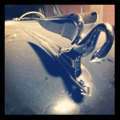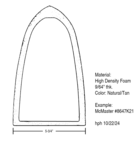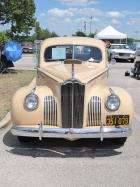|
Re: Tire Pressure
|
||||
|---|---|---|---|---|
|
Home away from home
|
I think I run about 40psi in mine.
Posted on: 2013/3/22 10:34
|
|||
|
West Peterson
1940 Packard 1808 w/Factory Air 1947 Chrysler Town and Country sedan 1970 Camaro RS packardinfo.com/xoops/html/modules/newbb/viewtopic.php?topic_id=4307&forum=10 aaca.org/ |
||||
|
||||
|
Re: Tire Pressure
|
||||
|---|---|---|---|---|
|
Not too shy to talk
|
Are yours bias ply or radial!?
Posted on: 2013/3/22 10:41
|
|||
|
1952 Packard 200
|
||||
|
||||
|
Re: Tire Pressure
|
||||
|---|---|---|---|---|
|
Just can't stay away

|
24-25 psi should be just about right. Because these tires are the same type (bias-ply) as originally specified, you can go by the original recommendation. Bias ply tires have much stiffer sidewalls than radials do, so you can get proper performance with lower pressure.
When choosing pressures, the manufacturer is always trying to balance ride quality, tire wear, and safety. I wouldn't go any lower than 24 psi, but you could go up a bit to 30 psi or so (provided that's under the max, which it should be) and see how the handling and ride compare. An overinflated tire will not make full use of the contact patch, so going to the absolute max pressure is unwise. Jist as an aside, I run radials on my car and have settled on 40 psi as the best radial tire pressure.
Posted on: 2013/3/22 10:45
|
|||
|
||||
|
Re: Tire Pressure
|
||||
|---|---|---|---|---|
|
Home away from home

|
I've got 820-15's on my 5406, and according to the Packard service adviser update, the correct inflation is 22/20. I recall the original spec of 24/24, which provided a noticeably harsher ride (esp. over bumps and pavement irregularities) with no improvement in handling...very un Packard like!
There's no harm done keeping the tires at 24 if you like that pressure, you typically get better MPG and handling with higher pressures, as well as improved tire life, although the couple of lbs. we're talking about would probably provide negligible results, especially if you only use it as a Sunday cruiser. As a FWIW, if your car is original and you prefer firmer handling (these cars actually handled well given their size and weight), then it might be worthwhile to change out the bushings in the suspension and install new shocks.
Posted on: 2013/3/22 13:02
|
|||
|
1954 black Patrician, unrestored, mostly original, minty!!
|
||||
|
||||
|
Re: Tire Pressure
|
||||
|---|---|---|---|---|
|
Forum Ambassador

|
It's not uncommon to find cars today with tires of different sizes or construction or capacity ratings than were originaly specified. For example 6-ply "rated" tires substituted for original full 6-ply, and so on. And finances might cause some of us to undersize a new tire purchase a bit. So.... the original inflation specs may or may not be the best guideline.
When I first put new tires on a car, I estimate the road weight of the car with a typical passenger load, gas, oil, water, tools, etc. Then I mulitply the maximum load rating (at it's maximum inflation pressure) of the tire by 4 and compare to the gross vehicle weight. If I've got lots of freeboard then I know I can go to lower pressures for a gentler ride if I wish. But if I find I'm right at or neat the cusp of the vehicle weight, I keep the pressure at or near the maximum inflation pressure. This is a lesson some learned bitterly in the Ford Exlorer/Firestone tire fiasco of some years back! My cold inflation pressures for both cars is about 4psi below the max.
Posted on: 2013/3/22 14:04
|
|||
|
||||
|
Re: Tire Pressure
|
||||
|---|---|---|---|---|
|
Home away from home

|
I would use the vehicle spec from Packard when using bias ply tires unless the tire company says otherwise.
Coker specifies its own tire pressures for radials so I would use that for their tires. I would not use the maximum on the sidewall. For one thing running excessive tire pressures beats the daylights out of the suspension and frame. For after market radials that don't specify the same way Coker does I guess I would look for a vehicle with similar weight and axle loading and start with that or 75-80% of the sidewall max as a rule of thumb.
Posted on: 2013/3/22 14:14
|
|||
|
||||
|
Re: Tire Pressure
|
||||
|---|---|---|---|---|
|
Home away from home
|
Quote:
I run 40-45psi with my bias ply Firestones. I strongly believe that 20-25psi is way too low, and probably will shorten the life of your tire. Your tire generates a lot more heat when the pressure is that low. At the higher pressure, I am not witnessing any abnormal wear, either. I think the number on the sidewall is the maximum pressure under maximum load rating.
Posted on: 2013/3/22 16:10
|
|||
|
West Peterson
1940 Packard 1808 w/Factory Air 1947 Chrysler Town and Country sedan 1970 Camaro RS packardinfo.com/xoops/html/modules/newbb/viewtopic.php?topic_id=4307&forum=10 aaca.org/ |
||||
|
||||
|
Re: Tire Pressure
|
||||
|---|---|---|---|---|
|
Forum Ambassador

|
West - that's a conventional bias-ply tire & tube? Geez ....that sounds extremely overinflated and dangerous to my thinking. And contact area on the pavement must be very small.
Posted on: 2013/3/22 17:20
|
|||
|
||||
|
Re: Tire Pressure
|
||||
|---|---|---|---|---|
|
Home away from home

|
In "Fear and Loathing in Las Vegas" they cranked the bias tire pressures of their 60's Chevy up to 75 psi because they thought the tires felt soft.
But that is a novel after all. The GM spec COLD was 26 front, 28 rear with 4 psi adjustment for over 75 mph, and 24 psi optional for a softer ride and light loadings. Pressures increase 4-6 psi on the road.
Posted on: 2013/3/22 21:36
|
|||
|
||||







